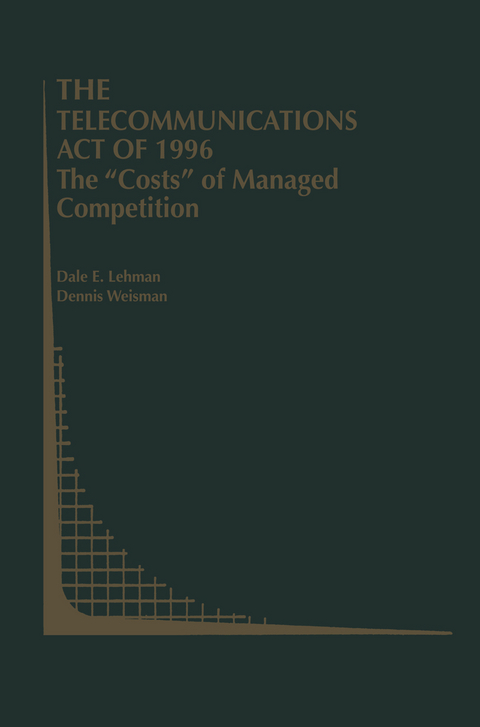
The Telecommunications Act of 1996: The “Costs” of Managed Competition
Springer-Verlag New York Inc.
978-1-4613-6937-0 (ISBN)
Three principal themes are developed in this book. First, there has been a coordination failure between Congress and the FCC in translating the principles embodied in the Act into practice. The authors provide evidence for this by analyzing stock market reactions to legislative and regulatory actions. This coordination failure was largely predictable, given the ambiguity in the Act, as well as conflicting jurisdictions between the FCC and the states.
Second, the Act calls for wholesale prices to be `based on cost.' Regulators adopted a costing standard (TELRIC) that provides a means to subsidize competitive entry in local telephone service markets. The ready adoption of the TELRIC standard by regulators is shown to be tied to the third theme: price cap regulation provides regulators with `insurance' against the adverse effects of competition in local telephone markets. Statistical analysis reveals that regulators in price cap states set uniformly lower unbundled network element prices (lower barriers to entry) in comparison with regulators in rate-of-return and earnings sharing states. The result is a triumph of regulatory processes over market processes - the antithesis of the purpose of the Act.
1 Introduction and Overview.- 2 Industry Trends and Market Structure.- 2.1 Industry Trends.- 2.2 Congressional Expectations.- 2.3 Demand Side Considerations.- 2.4 Public Policy Issues.- 2.5 Does Size Matter?.- 2.6 RBOC Entry Into InterLATA Long Distance.- 2.7 The Future.- 3 The Stock Market Reacts.- 3.1 Introduction.- 3.2 Stock Prices.- 3.3 Events Analysis.- Appendix 3-1: Alternative Events Analysis.- 4 A Jurisdictional Model.- 4.1 Introduction.- 4.2 Benchmark Result.- 4.3 The Multiple Agent Model.- 4.4 Who Sets Wholesale Prices?.- 5 The FCC’s Efficient- Firm Standard — Telric.- 5.1 Introduction.- 5.2 Statutory And Regulatory Costing Standards.- 5.3 The Efficient-Firm vs. The Price Cap Approach.- 5.4 Strategic Behavior.- 5.5 The Paradox Of Disparate Cost Standards.- 5.6 Conclusions.- 6 Back To The Future.- 6.1 Introduction.- 6.2 Historical Notes.- 6.3 Embedded And Forward-Looking Costs.- 6.4 Methodology.- 6.5 Base Case Scenario.- 6.6 Decreasing Investment Costs.- 6.7 Asymmetric Depreciation Periods.- 6.8 Simulation Results.- 6.9 Empirical Analysis.- 6.10 Conclusions.- Appendix 6-1: Assumptions Used In The Sensitivity Analysis.- 7 Explaining State Regulatory Actions.- 7.1 Introduction.- 7.2 PCR In Theory And Practice.- 7.3 Principles To Foster Regulatory Commitment.- 7.4 The Economic And Legal FoundationsOf A Complete Price Cap.- 7.5 Policy Implications.- Appendix 7-1: Data Used In The Regressions.- Appendix 7-2: Additional Empirical Results.- 8 Conclusions.- References.- Name Index.
| Erscheint lt. Verlag | 2.11.2012 |
|---|---|
| Reihe/Serie | Topics in Regulatory Economics and Policy ; 36 |
| Zusatzinfo | X, 128 p. |
| Verlagsort | New York, NY |
| Sprache | englisch |
| Maße | 155 x 235 mm |
| Themenwelt | Sachbuch/Ratgeber ► Natur / Technik ► Garten |
| Naturwissenschaften ► Biologie ► Ökologie / Naturschutz | |
| Sozialwissenschaften ► Politik / Verwaltung ► Staat / Verwaltung | |
| Technik ► Elektrotechnik / Energietechnik | |
| Wirtschaft ► Volkswirtschaftslehre ► Mikroökonomie | |
| Wirtschaft ► Volkswirtschaftslehre ► Wirtschaftspolitik | |
| ISBN-10 | 1-4613-6937-1 / 1461369371 |
| ISBN-13 | 978-1-4613-6937-0 / 9781461369370 |
| Zustand | Neuware |
| Haben Sie eine Frage zum Produkt? |
aus dem Bereich


